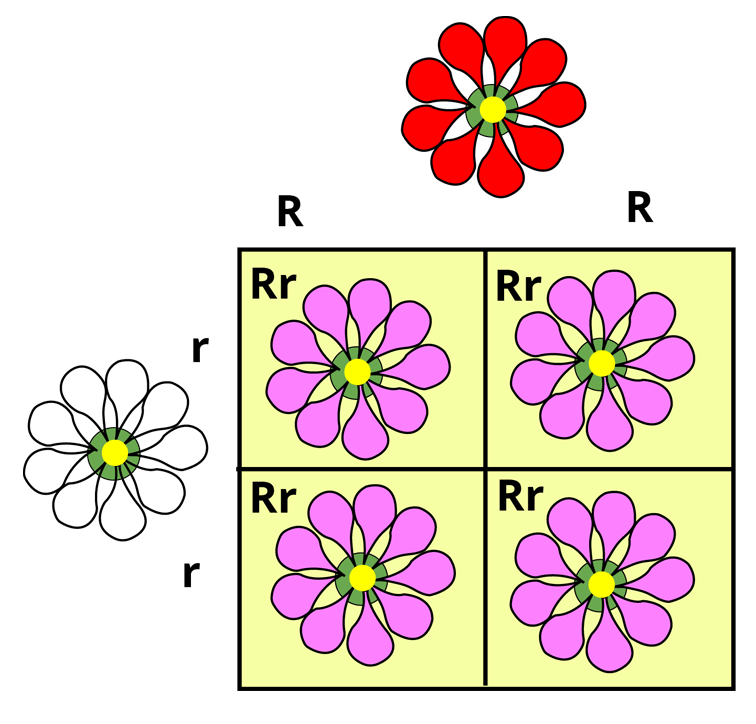




Principles of Inheritance and Variation NEET Notes and Important Questions
This article includes the notes of the chapter ‘Principles of Inheritance and Variation’ as per the NEET syllabus for biology. This article will help out the NEET 2022 aspirants as it contains the main and important topics for the last minute revision.
Candidates will get all the information about all the important topics and an insight into the exam pattern. After reading these Principle of Inheritance and Variation notes for NEET, students can find out all the answers to the important questions related to the chapter such as what is a flower and describe its different parts of a flower, what is pre fertilization events: microsporogenesis and megasporogenesis, what is pollination and its types, what is fertilization, why double fertilization is observed in angiosperms, what are post fertilization events, what is apomixis and polyembryony.
Important Topics of Principles of Inheritance and Variation
Mendel’s Laws Of Inheritance
Inheritance of One Gene
Law of Dominance
Law of Segregation
Incomplete Dominance
Codominance
Inheritance Of Two Gene
Law of Independent Assortment
Polygenic Inheritance
Pleiotropy
Sex Determination
Sex Determination in Humans
Sex Determination in Honey Bee
Mutation
Genetic Disorders
Mendelian Disorders
Chromosomal Disorders
Important Concepts
Terminologies
Heredity: It is a process in which there is a transformation of heritable traits to offsprings from parents.
Genetics: Genetics is a department of life science know-how that deals with the study of genes, genetic variation and the transmission of the characters from parents to offspring.
Inheritance: The process of genetic traits being transferred from parents to offspring is called inheritance in biology. It refers to the gene transmission from one generation to another. The genetic information is carried by genes, which is inherited by progeny.
Variation: Difference between cells is called variations, genetic differences or environmental factors causing organisms of any species
Mendel’s Principles of Inheritance
Mendel established the hereditary principle working on garden peas. He selected 14 true breeding plants which had 7 distinguishable characters and had two opposite characters.
Mendel called factors for genes and alleles were the factors coded for opposite trait pairs. He observed and gave three laws of inheritance:
Law of Dominance: It states that in the formation of the heterozygote, one of the alleles is dominant, and the dominant allele is expressed within the phenotype. So, while homozygous tall with (TT) alleles are crossed with dwarf (tt) plants, all the resulting offspring are tall and feature the tall dominant trait with genotype Tt.
Law of Segregation: According to it, during gamete formation at the meiosis stage, separation of each allele can be observed. So, without any blending, the characters are passed to gametes. Also, different kinds of gametes are produced in heterozygotes while only one type in homozygous.
Law of Independent Assortment: This law states that when two pairs of traits are combined in a hybrid, the segregation of one pair of characters is independent of the other pair of characters.
Test Cross: It is to discover the dominant trait showing the genotype of the plant, the given plant is crossed with the homozygous recessive. The two observations are:
If only the dominant trait is shown by the phenotype of offspring, then homozygote to the dominant trait is the parent plant.
If the offspring produced are of both phenotypes, then the parent plant was heterozygote to the dominant trait.
Incomplete Dominance
If a cross is done between a homozygous red(R1R1) and homozygous white-flowered plant (W1 W1), then pink coloured flowers of the variety (R1W1) will be produced in the first generation. It defines that alleles of red and white coloured flowers were unable to dominate over one another, thus showing incomplete dominance.
Thus, “the law of incomplete dominance says that when none of the two alleles exerts complete dominance over the other, the offspring will be a mixture of parents’ phenotypes”.

Co-Dominance
Codominance is a natural phenomenon where a particular feature gets expressed into an offspring in which at least two characteristics are involved together. It explains that in all genes the same features will express themselves, reflecting in visible character building. This is known as co-dominance as it is a complex phenomenon.

Chromosomal Theory of Inheritance
It is the fundamental genetic theory that recognizes bearers of genetic material as chromosomes. The two scientists who have been credited with developing the Inheritance Chromosomal Theory are Theodor Boveri and Walter Sutton.
Linkage
On the same chromosome, other DNA sequences or the close relationship of genes is known as linkage. The closer two genes will stick to each other on the chromosome, the more likely they are to be passed down to the child from the parent.
Recombination
To form new allele combinations, breaking and recombining segments of DNA is called recombination. From this recombination process, genetic variety at the gene level originates. Between species, it reflects differences in DNA sequences.
Linkage and Recombination
Multiple Alleles: Multiple alleles is, for a particular gene the occurrence of three or more than three alleles. The contrasting or different forms of a gene are Alleles. For example, for height coding genes, one allele can be for tall, whereas the other can be for a dwarf.
Polygenic Inheritance: Polygenic inheritance refers to the phenotype controlled by genes. Herein, for traits such as eye colour, height, etc various genotypes are responsible, in human beings or even plants.
Pleiotropy: When many phenotypic traits are controlled by a single gene, it is called a pleiotropic gene. For example, in the gene coding for the enzyme phenylalanine hydroxylase a single gene mutation results in the disease known as phenylketonuria, which is characterized by reduced hair, mental retardation, and skin pigmentation
Sex Determination
Sex determination is a genes complex system, these coding to proteins and their functions on various target organs that determine the development of sexual characteristics in an organism cumulatively.
Sex Determination in Different Animals:
Humans - XY(males) and XX(females)
Grasshopper - XO (males) and XX(females)
Drosophila - XY(males) and XX(females)
Birds - ZZ(males) ZW(females)
Sex Determination in Honey Bees
Fertilization or non-fertilization of eggs normally determines honeybees sex, rather than the absence or presence of sex chromosomes.
In honey bees, the female is diploid while the male is haploid.
As male insects develop partheno-genetically from unfertilized eggs they are haploid.
The phenomenon is called arrhenotoky.
Females grow from fertilized eggs and are hence diploid.
In some insects like bees, ants, and wasps haplodiploidy occurs.
Mutation
It is a change in the nucleotide sequence of the genome of a living organism, virus, or extrachromosomal DNA. Viral genomes can be of DNA/RNA.
Genetic Disorders
There are many disorders in human beings that are inherited and caused due to mutation in the gene or alteration in chromosomes.
Pedigree Analysis helps in determining the risk of getting a genetic disorder in the offspring by studying the inheritance pattern of a particular trait present in various generations of an individual.
Mendelian disorders
Chromosomal disorders
Solved Examples from Chapter - Principles of Inheritance and Variation
1. Differentiate between Dominant and Recessive.
Ans:
2. Differentiate Between Homozygous and Heterozygous.
Ans:
Solved Problems of Previous Year Questions from the Chapter
1. A gene showing codominance has
a) One allele dominant on the other
b) Alleles tightly linked on the same chromosome
c) Alleles that are recessive to each other
d) Both alleles independently expressed in the heterozygote
Ans: d) Both alleles independently expressed in the heterozygote
In codominance, two alleles of a gene pair independently express themselves in a heterozygote. Codominance is very easy to spot in plants and animals that have more than one pigment colour. Spotted cows and flowers with petals of two different colours are examples of codominance.
2. In his classic experiments on pea plants, Mendel did not use
a) Seed colour
b) Pod length
c) Seed shape
d) Flower position
Ans: b) Pod length
After conducting experiments on pea plants using 7 traits, Mendel gave the law of segregation, Law of dominance and law of independent assortment.
3. Which one of those given below is the period of Mendel's hybridisation experiments?
a) 1856 - 1863
b) 1840 - 1850
c) 1857 - 1869
d) 1870 - 1877
Ans: a) 1856 - 1863
Mendel conducted hybridization experiments on the Pea plant for 7 years between 1856 to 1863 and his data was published in 1865.
Practice Questions
1. In a human child, sex is determined by
a) Size and the number of sperms in semen
b) Size of egg to be fertilized
c) Sex chromosomes of the father
d) Sex chromosomes of the mother
Ans: c) Sex chromosomes of the father
The beginning of male gametophyte is microspore. Humans contain 23 pairs of chromosomes, the 23rd pair is the sex chromosome (which determines the sex whether the offspring will be male or female). Therefore, in human beings, the sex of a child is determined depending upon which type of male gamete (i.e. XY) fertilizes with the female gamete (i.e. XX).
2. A dihybrid cross produces the following progeny - AaBb = 240; Aabb =754; aaBb = 746; aabb = 260. What is the distance between the two genes on the chromosome?
a) 12.5 map units
b) 1 map unit
c) 20 map units
d) 25 map units
Ans: d) 25 map units
Recombination frequency =Number of recombination / Total number of properties X 100
= 4/16 X 100
= 25 map units
Conclusion
This article contains all the important information as per the NEET 2022 exam and can be really helpful for a quick and effective revision. It covers all the important topics, questions from previous year's NEET question papers, NEET mock test and Biology NCERT. Surely try the practice questions on your own to test your talent in this chapter.
NEET Chapter - General Principles and Processes of Isolation of Elements

 Share
ShareFAQs on NEET Chapter - General Principles and Processes of Isolation of Elements
1. Why is it important to study the Inheritance and Variation of Traits?
Understanding heredity improves the ability to predict and control what traits are passed from parent to child. Agriculture can produce more food in areas that were previously unable to support crops when plants are bred to live in more extreme climates.
2. What is the inheritance principle?
Inheritance involves passing discrete units of inheritance, or genes, from parents to offspring. Mendel found that paired pea traits were either dominant or recessive.
3. What are the principal patterns of inheritance?
There are five basic modes of inheritance for single-gene diseases: autosomal dominant, autosomal recessive, X-linked dominant, X-linked recessive, and mitochondrial.








 Watch Video
Watch Video
